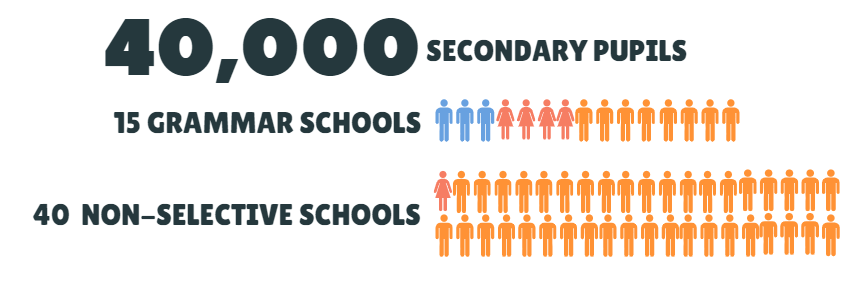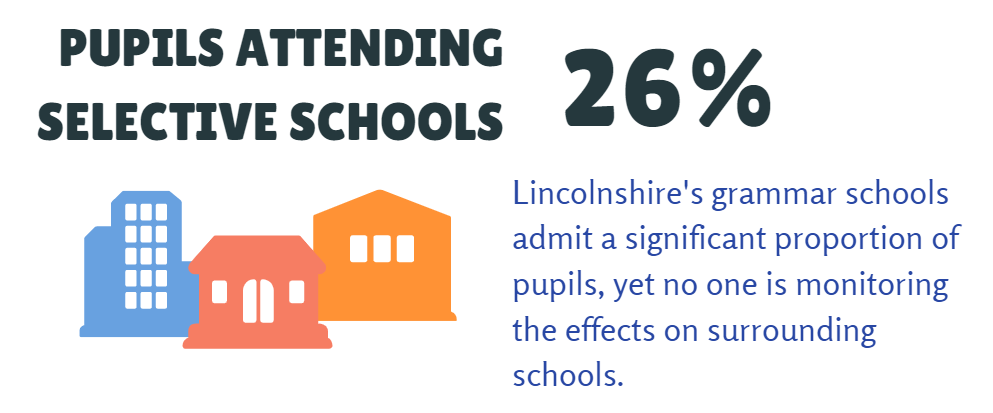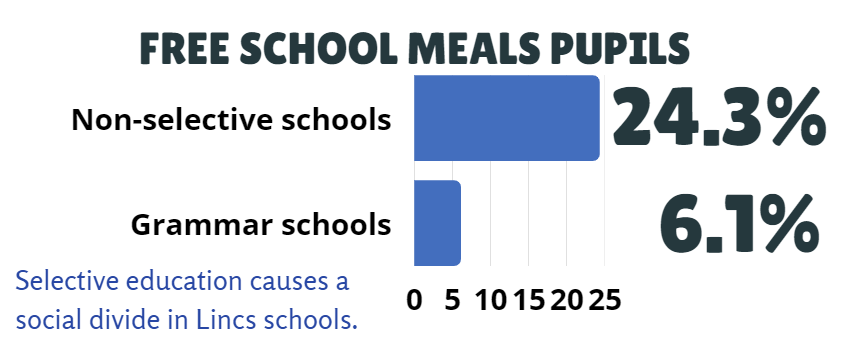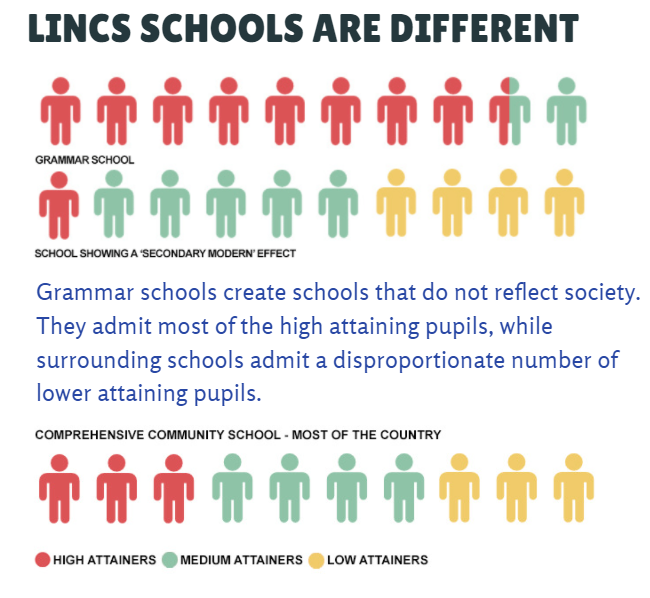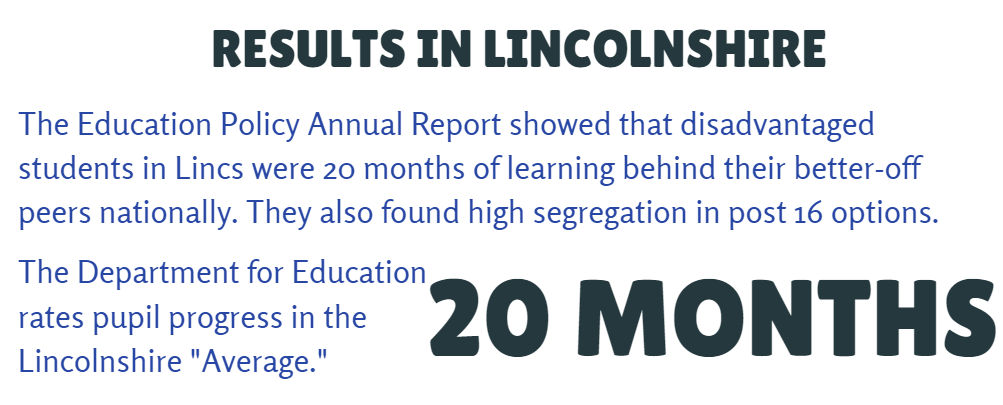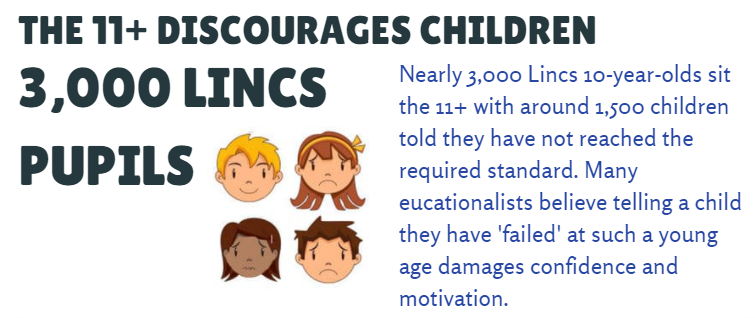 Selective education guide – Lincolnshire
Selective education guide – Lincolnshire
BACKGROUND
Lincolnshire, like Buckinghamshire and Kent, is a selective county. There are a total of 15 grammar schools attended by a large proportion of the county’s pupils. Schools in the city of Lincoln, however, are non-selective. The city got rid of its grammar schools in the 1970s along with the vast majority of local authorities in England.
Check out our map of selective schools in England to find out more about Lincolnshire grammar schools. The map gives the percentage of disadvantaged pupils, the percentage of pupils attending a grammar school who are likely to have come from a fee-paying ‘prep’ school, and the relative selectivity of every grammar school in Lincolnshire. View the map HERE.
THE PROBLEMS
In every area where academic selection still exists there are some common problems. For example,
- Grammar schools admit fewer disadvantaged pupils than non-selective schools. Grammar schools are also more likely to admit pupils from more advantaged families.
- In some Lincolnshire grammar schools, 4% of pupils have been privately educated. In others, as many as 17% previously attended a fee-paying school.
- Tuition for the 11-plus ‘buys advantage’. Better-off families can afford private coaching while poorer families may feel compelled to pay for tuition they can ill afford.
- Sitting the 11-plus is stressful and can damage a child’s confidence.
- The 11-plus has been proven to lack accuracy because it takes place while children are still developing academically.
- Research shows the proportion of children with Special Educational Needs (SEN) attending grammar schools is small. For many children with additional learning needs such as dyslexia and attention deficit disorders, the 11-plus test is inaccessible. The same children often perform very well academically outside a test situation.
- GCSE results in areas with grammar schools are on a par with, or worse than, areas that have only comprehensive schools. Research has shown that children who attend selective schools would achieve broadly the same results if they attended a non-selective school.
The percentage of pupils attending grammar schools in Lincolnshire
26% of all Lincolnshire’s secondary school pupils attend a grammar school. This is a significant proportion of pupils which means the impact on the pupil population of surrounding schools is also significant.
Although the DfE acknowledges that selective areas such as Lincolnshire are offering a different type of education than most other areas of England, the impact of a local authority educating its pupils in an alternative education system is never scrutinised. The lack of checks and reporting requirements means the full impact of a selective school system cannot be fully understood. There are many aspects of selection which remain shrouded in secrecy.
A social divide in Lincolnshire secondary schools
In common with all grammar schools, disadvantaged pupils are underrepresented in Lincolnshire’s grammars. As a result, the county’s non-selective schools educate a far greater proportion of pupils on free school meals.
Many academics argue that a selective education system risks creating the kind of divisions which go beyond the schools themselves and can affect the wider community more generally.
11-plus tuition businesses profit from anxious parents in Lincs
Although some 11-plus test companies claim that their tests are ‘tutor proof’ most parents believe otherwise. Parents can spend thousands of pounds preparing children for 11-plus tests. Test tuition means the test isn’t a level playing field. Children from more comfortably off backgrounds are more likely to have received coaching and are therefore more likely to pass the test and gain a grammar school place.
Lincs schools are not true comprehensive schools
Grammar schools change the pupil profile of other schools in the area. If a large number of higher attaining pupils attend grammar schools then surrounding schools find themselves with a pupil population which is skewed, with a disproportionate amount of moderate and lower attaining pupils and pupils with additional learning needs. This impacts on subject choice (fewer subjects available than at a grammar school) and teacher recruitment. Non-selective schools in areas with grammar schools cannot be ‘true’ comprehensives and tend to underperform compared to comprehensive schools.
Results are poor for disadvantaged pupils in Lincolnshire
In areas with a high proportion of selective schools, a ‘secondary modern’ effect is created with non-selective schools often unfairly viewed as ‘second best’. Owing to their skewed pupil population, overall results for non-selective schools in selective areas tend to be lower than for comprehensives in non-selective areas.
In spite of the high proportion of grammar school pupils in Lincolnshire, overall pupil progress is only rated ‘average’ by the DfE.
Lincolnshire’s 11-plus can damage children’s confidence
Many children feel demotivated by a ‘fail’ in the 11-plus. We believe all children should start secondary school feeling positive about their academic ability. The success of non-selective schools in most areas of the country proves that there is no need to divide children by using an outdated and discredited test.
The Lincolnshire 11-plus is a flawed exam
Most areas that still have grammar schools have moved away from ‘ability’ tests, and instead use tests based on curriculum skills. This is in part because IQ style tests have been discredited. Lincolnshire is unusual in that its grammar schools still attempt to judge ‘ability’ not academic attainment. The 11-plus has a controversial history. Read more about this and Cyril Burt’s discredited resarch into child ‘intelligence’ here.
More information
You can find more information about Lincolnshire grammar schools and the 11-plus on the Lincolnshire Consortium of Grammar Schools website.
Want to end the 11-plus in Lincolnshire?
Join Comprehensive Future’s campaign to end the 11-plus.
To learn about the data sources for our interactive map and selective education guides click here. If you spot any errors in the data for any area, please let us know.

